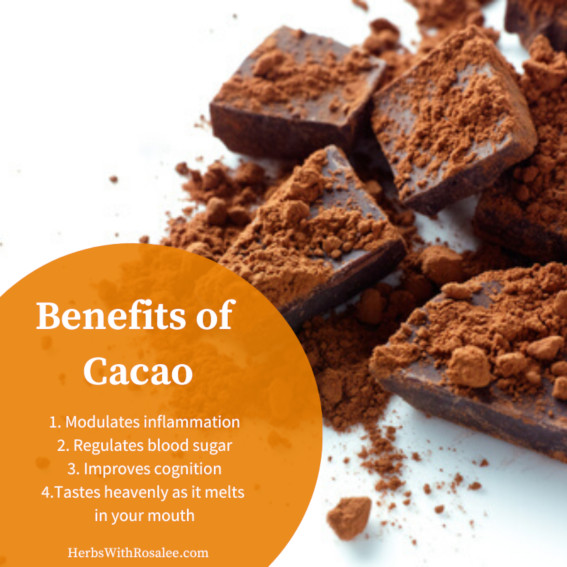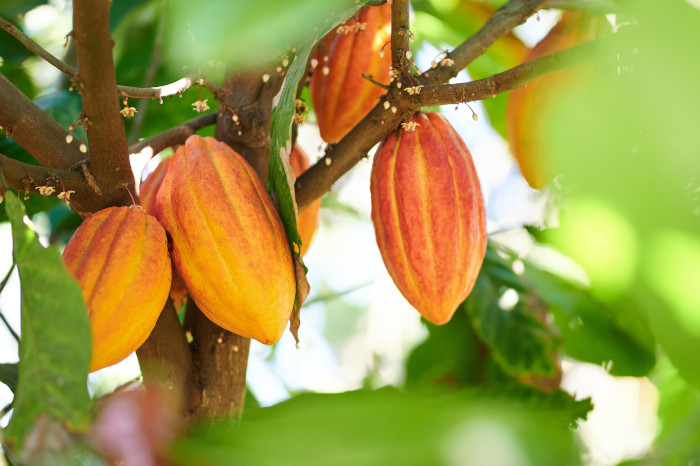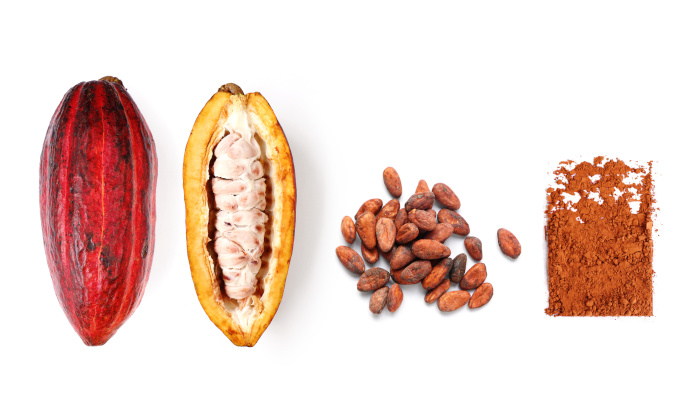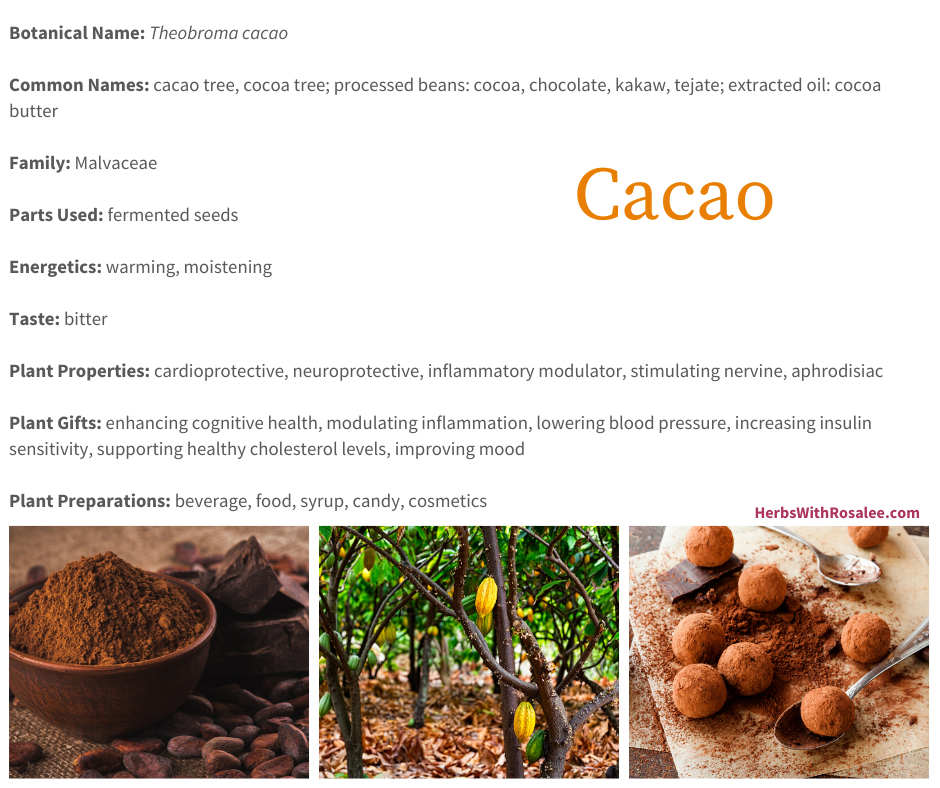Get weekly tips, recipes, and my Herbal Jumpstart e-course! Sign up for free today.

Cacao Benefits
Share this! |
|
When you think of chocolate or cacao, you may immediately think of chocolate drops wrapped in silver foil or perhaps your favorite chocolate bar or ice cream. Very few people think of a tropical tree standing erect in the sunshine while growing succulent pods, which harbor a creamy mucilaginous pulp that encases many small bitter seeds.
For at least 4,000 years, people in Central and South America have been harvesting and preparing cacao for the many cacao benefits. For some cultures it wasn’t simply a food or a medicine but a fully integrated part of their lives and was even used as currency. The Aztec empire required taxes to be paid in cacao beans.
It may be strange to think of cacao (Theobroma cacao) as an herb since we mainly see the final product, which is often heavy on sugar and light on cacao. But, cacao does come from a plant and, as you’ll see, it offers many powerful health benefits. While cacao’s gifts are complex and may never be fully understood, we do know that its high content of inflammation-modulating flavanoids is a strong part of its medicine. While scientists have tried to isolate certain cacao flavanoids, human clinical trials show the most health benefits when the whole cacao bean is consumed.
Cacao Benefits for Mood and Energy Levels
Many people are drawn to cacao, not only for the decadent taste, but also because of how it makes them feel. Widely known to be an aphrodisiac, or simply a way to woo your partner or love interest, people in the United States buy around 60 million pounds of chocolate candies during the week of Valentine’s Day.1
Cacao contains very small amounts of caffeine and larger amounts of theobromine, which acts as a stimulant similar to caffeine. Theobromine is a bitter alkaloid that can dilate blood vessels and act as a mild diuretic. Some people find that this stimulation can be unpleasant or aggravating their energy or moods.
Those not negatively sensitive to cacao’s stimulating effects find that cacao can boost their energy levels. One study also showed that cacao could benefit people with chronic fatigue syndrome. In this small study, people with chronic fatigue who ate high-polyphenol chocolate found they had an improvement in their symptoms, including decreased anxiety.2
These mood-improving, stimulating, and anti-anxiety effects may explain part of the aphrodisiac lore surrounding cacao.
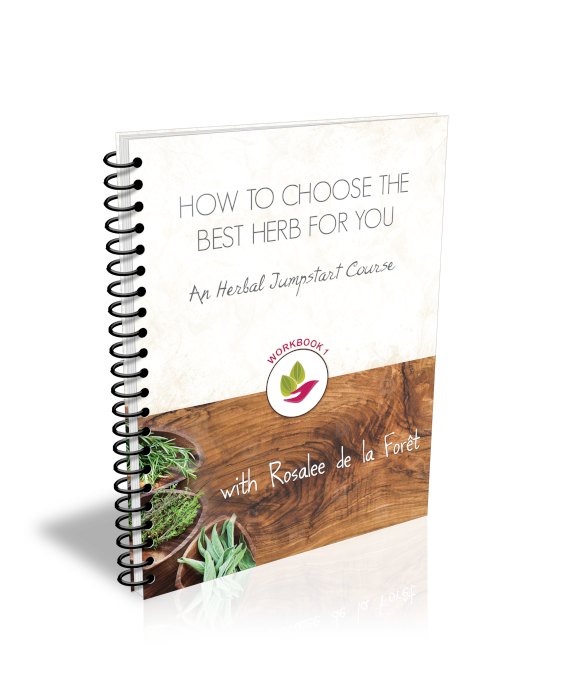
Choose the Best Herb for You!
The secret to using herbs successfully begins with knowing who YOU are.
Get started by taking my free Herbal Jumpstart e-course
By signing up for my free course you’ll also be joining my weekly newsletter where I send my best tips and herbal recipes. I never sell your information and you can easily unsubscribe at any time.
Cacao Benefits: Cacao Effects on the Brain
Perhaps one of the reasons we experience an improved mood when eating cacao is due to the many ways it improves cognitive function, such as alertness and memory. Researchers have found that cacao can improve cognitive function in both elderly and young people.3,4 Cacao simultaneously was found to lower blood pressure in the elderly and improve vision in the young people. Those are some awesome side effects!
Cacao Heart Benefits
Cacao may be best known for its ability to support heart health. In western civilization this realization came to researchers who were studying the Kuna people of coastal Panama, who have surprisingly healthy hearts. While there, researchers observed the Kuna drinking a cacao beverage multiple times throughout the day. When the researchers studied the samples back in the lab they realized that cacao was rich in flavonoids that are known to support heart health.
Numerous clinical trials have been performed using isolated constituents of cacao, as well as the whole bean. They have shown that dark chocolate preparations can reduce hypertension, increase beneficial cholesterol (HDL), and increase insulin sensitivity.5,6,7
Cacao Benefits for Insulin Sensitivity
Cacao seems like an unlikely substance for helping to prevent insulin resistance and type 2 diabetes, but there are several clinical studies showing it can do just that. Researchers surmise that cacao’s high antioxidant activity and inflammation-modulating abilities, combined with its ability to increase insulin sensitivity, make cacao a powerful ally in preventing this metabolic disease. For the most benefits, eating cacao without sugar is best.8,9
Cacao Benefits for Supple Skin
Cacao’s antioxidants also extend their gifts to supporting healthy skin. One study showed that women who consumed a high-flavanoid cacao beverage for 12 weeks had decreased photosensitivity (meaning increased protection from UV rays), increased circulation to the skin, decreased roughness of the skin, and better skin hydration.10
Cocoa butter is commonly used in herbal skin preparations, such as creams and body butters, to both protect and nourish the skin.
Cacao Benefits: The Cacao Plant
Cacao trees are broadleaf evergreen trees that grow in tropical climates (USDA Agricultural Zones 11-12). They prefer full sun to partial shade. Cacao trees originally come from Central and South America, but are now cultivated in tropical locations across the globe.
The tree grows to 20-30 feet tall. The leaves grow alternately, are glossy, bright green, oblong, and droop from the branches.
The flowers are small and pink and grow directly on the trunk or branches of the tree. The flowers can bloom at any time throughout the year.
The flowers grow into fruits, called cacao pods, which grow up to a foot long and three inches in diameter. The pods can be green, red, yellow, or yellow brown when they are ripe.
Inside the pods is a sweet and sour mucilaginous white pulp that can be eaten. Within the pulp are 20-60 cacao beans.
To prepare the beans into an edible product, they are fermented, dried, roasted, and then removed from their shell.
The beans (seeds) are high in cocoa butter, which can be extracted for use as a cosmetic or in cooking. Cacao powder has had the cocoa butter removed. Chocolate retains the cocoa butter.
Cacao Benefits: How to Buy Cacao
There are several important considerations when you want to buy cacao – not only for your health but also for the health of the planet.
All health benefits of cacao come from using products high in flavanoids and low in sugar. Eating cacao beans (sometimes called cacao nibs) and using 100% cacao powder is the best way to get the most flavonoid content.
When buying chocolate, look for bars that have at least 70% cacao. Higher levels are preferred for health benefits. Many chocolate companies offer chocolate bars at 85% cacao. If you prefer milk chocolate and find that dark chocolate doesn’t suit your palate, trying increasing the cacao content slowly over time. Many people find that, once their tastes adjust, they prefer dark chocolate.
Some major chocolate companies use horrific labor practices, including forced child labor and unfair wages. Cacao trees may also be grown using a lot of pesticides. When buying chocolate or cacao look for companies that are both fair trade and organic.
Dutch process cocoa powder is often used to make hot chocolate or other chocolate desserts. This product has a lower antioxidant content and is not recommended when choosing chocolate for its health benefits. If you are in the market for cocoa powder for baking or beverages, purchase plain cocoa powder or look for cacao powder, which is a less processed version with a higher flavonoid content.
Cacao Benefits: Plant Preparations
Cacao can be bought as cacao nibs, cacao powder, cocoa butter, or in a wide array of chocolate products.
Cacao nibs are 100% cacao and are one of the best ways to get the most benefits from cacao. These can be eaten as a snack and added to foods like smoothies, yogurts, ice cream, and others.
Cocoa powder is used for baking and can be added to many foods, from savory dishes like molé to sweet drinks like hot chocolate.
Cocoa butter is sold at bulk apothecaries such as Mountain Rose Herbs. You can use cocoa butter to make your own chocolate or cosmetic creams and body butters.
Making your own chocolate creations is easy and ensures you are using the best ingredients from high-flavanoid cacao, and with less sweetness than is often found in commercial products.
Cacao Dosage
The daily recommended dosage for cacao will vary among people and the products chosen. The EU Commission recently issued a statement saying that to get the heart health benefits of cacao, 2.5 grams of high-flavanoid cocoa powder or 10 grams of high-flavanoid dark chocolate is recommended.
Cacao Benefits: Special Considerations
- Avoid cacao if you are sensitive to its stimulating effects. (e.g., you feel nervous or anxious after consuming it).
- Cacao can cause insomnia in some people. Avoid eating it later in the day if this happens to you.
Citations for Cacao Benefits
Click to show/hide.
Rosalee is an herbalist and author of the bestselling book Alchemy of Herbs: Transform Everyday Ingredients Into Foods & Remedies That Healand co-author of the bestselling book Wild Remedies: How to Forage Healing Foods and Craft Your Own Herbal Medicine. She's a registered herbalist with the American Herbalist Guild and has taught thousands of students through her online courses. Read about how Rosalee went from having a terminal illness to being a bestselling author in her full story here.
